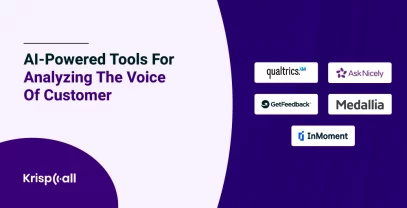Are you also a regular user of virtual assistants like Alexa, Siri, or Google Assistant to set reminders ⌛, call someone 📞, or play music🎵?
Maybe yes, and we all do that. But apart from that, 69.9 million people with smart home systems are not just using these to set reminders or play music. Multiple businesses are using this technology to improve customer service interactions.
Research shows that 80% of conversations can be handled by chatbots. Chatbots work this well because they use Natural Language Processing (NLP).
But how can you use it? 🤔 To answer this question, we have provided 9 ways to use customer service to boost efficiency for your business or brand, including the definition of natural language processing, the benefits of NLP in customer service, and how it is used.
Let’s dive in. 🌊
🔑 KEY HIGHLIGHTS
- Natural Language Processing is artificial intelligence that allows a computer to understand conversations and respond in a human tone.
- Natural Language Processing is used in customer service, from improving customer interactions to analyzing customers’ sentiments.
- Virtual assistants like Siri, Alexa, and Google Assistant also use some form of NLP for voice recognition.
- Natural Language Processing with AI chatbots communicate with customers quickly and provide real-time customer support without delays.
What is Natural Language Processing (NLP)?
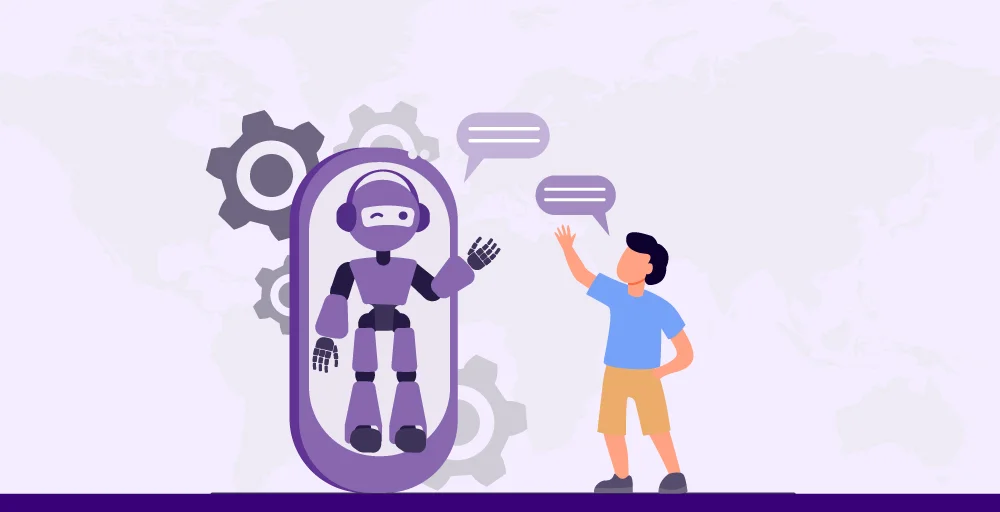
Natural Language Processing (NLP) is a type of artificial intelligence that enables understanding communication between humans and computers. Specifically, it is an AI component that humanizes conversations while interacting with customers and helps solve their problems and queries.
It is a form of artificial intelligence that allows computers to understand human language and respond in a human tone. In customer service, NLP is vital for interacting with customers, providing answers, handling queries, and routing calls.
For example, virtual assistants like Alexa and Google Assistant use NLP to respond to voice commands. Customer service chatbots use this to answer customers’ queries in real-time and Google Translate uses this to translate text into another language.
How is Natural Language Processing used in Customer Service?
Natural language processing is the root of AI for analyzing phone calls or messaging conversations. It is used in customer service by playing a role in enhancing customer interactions to analyze customers’ sentiments. This artificial intelligence also helps to gather customer insights and use them for creating customer-friendly approaches.
NPL plays an important role whenever spoken or written languages enter the customer journey. In contrast, the possibilities and capabilities of natural language processing can be upgraded in the coming days.
Advantages of NLP in Customer Service
The natural language process helps solve customer problems and plays a big role in customer service, enabling automated systems to respond to customer inquiries by understanding them.
Some of the advantages of NLP chatbots in customer service are:
- Providing responses: It generates the appropriate and suitable response according to the context of the user questions.
- Understand user input: It understands every text or voice input from the users and the message’s intent.
- Continuous learning: It is an AI, so it consistently learns from every interaction to improve accuracy and effectiveness in future responses.
- Smart process of human language: It can handle various language patterns like grammar, syntax, and spelling mistakes to make sense of the input.
9 Ways To Use NLP in Customer Service
Natural language processing is an important part of good customer service for businesses or companies. Without this, customers can’t get sufficient answers to their inquiries, solve their problems, and have a bad experience.
Here are some of the ways to use NLP in customer service:
1. Analyzing Customer Feedback
Customer feedback is always valuable data for any business. It helps you to know what is going wrong in your business and fix the issues. It also shows which part of your business people love. Both of these are important for improving according to the customer demands.
Analyzing and responding to customer feedback is vital since 83% of customers stay loyal to the brand that responds to complaints.
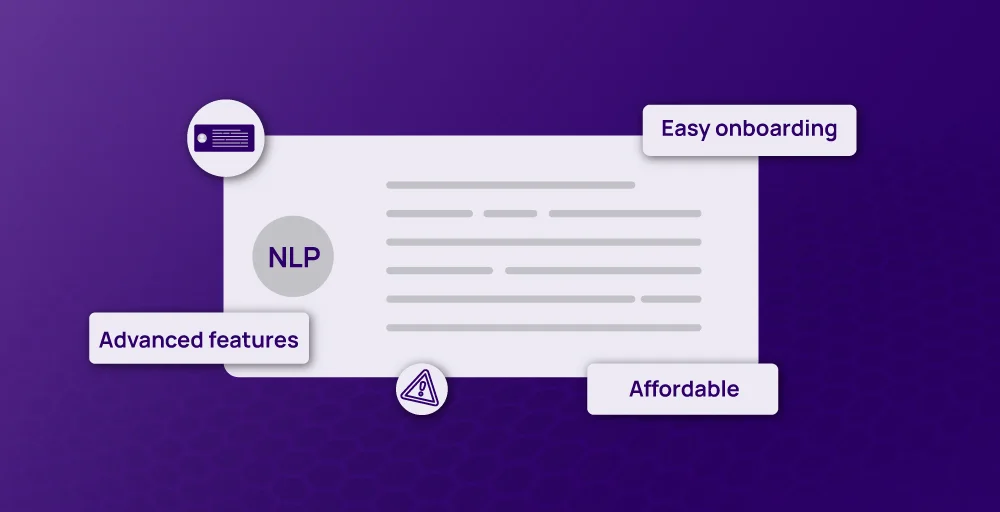
With NLP, you can easily identify phrases or words commonly used in customer reviews, such as “advanced,” “cheap,” and “bad.” This can also detect the topics in feedback forms, like “ easy onboarding” and “affordable plans.” Also, combining this NLP with sentiment analysis lets you get an overview of customer opinions.
2. Customer Service Chatbots and Live Chats
The use of AI chatbots enables you to communicate with customers quickly and provide real-time customer support without delays. These live chats and chatbots can greatly improve the customer support system and services.

You may wonder why you use live chats. The answer is simple: In today’s world, 46% of customers expect to have live chat on your website, making it the most preferred way to contact businesses. Whereas other media like email is 29% preferred and social media 16%.
Chatbots and live chats are not the same, but they are used interchangeably. Chatbots are NLP-powered AI, whereas customers chat with human agents in live chats. This AI chatbot is smart enough to communicate with customers without human intervention.
NLP also allows chatbots to interpret customer messages if they make grammatical errors or if the sentences are incomplete. Whenever there are many call queries in real time, an NLP-powered chatbot can free you from those by handling questions and passing the customers if human agents are needed or any complex issues occur.
😀 Related: 15 Live Chat Best Practices to Improve Customer Support
3. Agents Support
Many agents want to use machine learning software to cope with the high demand for customer support tickets because an average customer support agent can only handle 21 customer support tickets daily.
A Salesforce report, “State of Service,” shows that 69% of high-performing agents are searching for situations where they can utilize artificial intelligence. Conversational AI can be used to handle queries that are not that important or crucial to follow. This frees the agents and gives them time to handle complex issues and queries that require human touch.
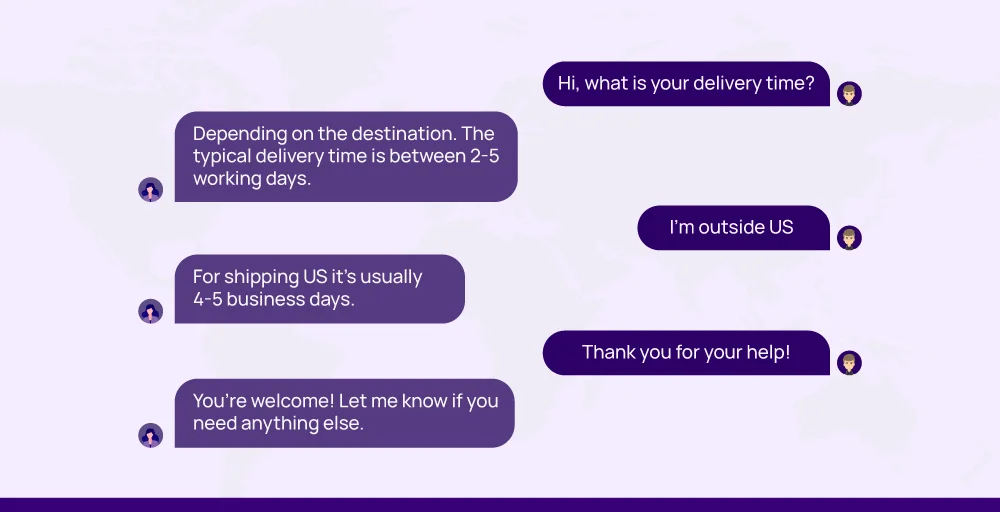
👉 Questions that can be handled with conversational AI:
“Can you provide the specifications of this laptop?”
“Is my order ready yet?”
“ What are the steps to reset my password?”
👉 Queries that require agents to answer and solve the problem:
“My bank account shows no balance; I need help ASAP.”
“The order was misplaced, and I need a refund.”
“I need personalized assistance to reactivate my account.”
4. Efficient Call Routing via IVR systems
IVR systems stand for Interactive Voice Responses; they use phrases to transfer you to a specific department. If you have ever called customer support and said, “Make a payment,” the call was routed to the finance department. That is how IVR works.
More customers will likely use this system to contact your team. You can accurately divert a customer’s call to the most relevant line using conversational AI. Here, the IVR becomes an intelligent virtual assistant (IVA).
NLP understands the caller’s request and can assist them with better results. Customers can simply describe their needs in their own way, and IVAs can analyze the phrases and route the call to the specific department or support agent. This reduces the wait times for the customers, eventually increasing their trust and reliability and eliminating their probable frustrations.
5. Business Data Analysis

NLP allows businesses to analyze customer feedback data and obtain information from elsewhere. Suppose you get around 100 feedbacks or complaints. Now, you need to know the reason for customer dissatisfaction or disagreement.
You surveyed to identify the major problems and asked customers to tick the boxes where they feel bad service. And the boxes were;
- Complicated onboarding process.
- Too much expensive.
- Bad customer support.
- Personal issues.
Now, the chances of the maximum number of people ticking the wrong box are high because not all the problems are specified, and making a checkbox for each problem is impossible. If they also tick the right box, the correct information won’t be available for us to find the exact problem.
For instance, if the customer ticks the “too expensive” checkbox, the entire team starts to find a way to minimize costs and puts their efforts into doing that. But the problem could be a billing issue or a delay while making payment. They chose the most relevant box since they didn’t have that option.
This type of misinterpreted information can harm the business like nothing else. This is why NLP is essential. It categorizes feedback by its nature and gives an overview of negative and positive feedback. This helps determine whether the business is going in the right direction.
With NLP, you don’t need to create a checkbox and ask customers to fill it out. Instead, you can easily get an overview of all the bad and good feedback, which helps you find room for improvement.
6. Routing Customer Tickets Quickly
Whenever customers try to contact your customer service, they are given a support ticket, which goes to your support team’s queue. NLP can help to streamline this process.
Conversational AI can understand the ticket category and divert the support tickets to the most appropriate person, which helps resolve the issues faster.
For example, if the customer says, “I need assistance with the billings,” if the system lacks NLP capabilities, this ticket will also be added to the general queue. It will only be solved after manual interventions and routes to the finance department.
But suppose the system is enriched with NLP capabilities. In that case, it is smart enough to recognize that the “billing” term is associated with a financial nature and route it to the appropriate department, which in this case is the finance department. The exact working procedure applies to words or phrases that boost customer service experience.
7. Customer Satisfaction and Sentiment Analysis
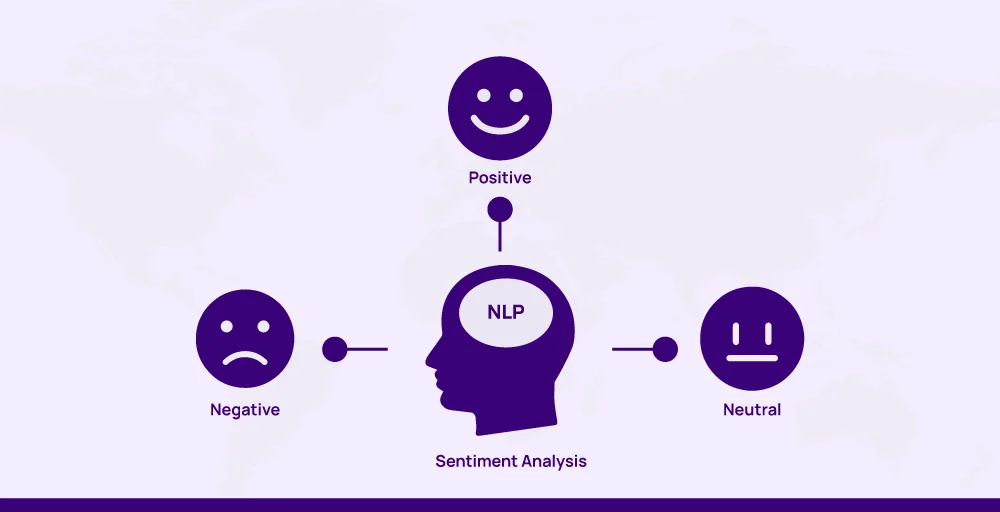
Customer feedback can filter out customer satisfaction, but reading it all one by one? No way, that’s too much. 😩
To understand how customers feel about the business, you must go through all the data yourself. But, by using NLP sentiment analysis determines the inside emotions from the feedback forms, such as:
- “I had an awesome experience with this company.”
- “It’s an easy onboarding process.”
- “The service was better than expected.”
If you get these responses, the sentiment analysis will interpret those words as emotions. Those words can be “awesome,” “easy,” and “better” in the above context.
Now, the machine learning system analyzes and tells you that most responses are positive. This gives an overview of your performance. Also, this system filters customers’ frustrated and angry messages, allowing agents to prioritize them.
This lets the customer be fulfilled and treated well, and monitoring performance helps to improve services consistently, which eventually boosts customer satisfaction.
8. Applications of Speech to text
Maybe you have been asking your personal virtual assistant, including Alexa and Siri, to call someone, play music, set reminders, or plan the route to any location. They all use voice recognition systems.

Likewise, in customer service, you can use voice recognition systems for:
- Translate any queries of the customer from their spoken language to yours.
- Enabling the customer to access accounts with their voice.
- Also, integrating your software with voice assistants.
Here is a fact: None of these things works without using NLP, which is used to interpret the spoken word or phrases.
9. Search Bars with a Knowledge Base
Whenever someone goes to your website, they try to search for something through the search bar. If the results aren’t relevant, they leave your website, eventually impacting metrics like conversions, time, and bounce rate.
And the proper search result can’t be obtained without using some form of NLP. The machine learning software uses interpretation to find the meaning of queries and understand what the user is looking for. Even if the text is not in proper English, contains any grammatical errors, or is misspelled.
Here are a few ways how NLP helps in improving customer service in your site’s search bars.
- Users can find the relevant information, which allows them to be on the site, increasing the bounce rate.
- NLP helps deliver accurate search results by understanding the context and intent of a customer query.
- The flexibility of typing queries in any language, where NLP interprets and gives results according to the user query.
Using Natural language processing on your sites will help meet visitors’ needs and improve customer satisfaction.
Conclusion
Natural language processing is helpful for businesses providing customer service. It generates the needed response and guides the customer to solve their problems. With smart understanding, it can handle grammatical or syntax errors and respond according to the customer’s intent. The continuous learning pattern makes it more powerful, useful, and capable on a daily basis.
Businesses can use NLP to provide accurate and efficient agent support and boost customer interactions. It helps route calls to the needed department using the IVR system. Popular assistants like Alexa and Siri also use some form of NLP for voice recognition. It also involves AI chatbots, Conversational AI for handling customer inquiries without human interventions.
FAQs
What is NLP in Customer Service?
Net language processing (NLP) is a form of artificial intelligence used in customer service to improve customer interactions with AI chatbots. It is used in every spoken or written language.
What do you mean by NLP in CRM?
NLP in Customer Relationship Management (CRM) means the use of Natural Language Processing to analyze overall customer interactions to improve communication. This also includes automating responses to common customer queries and making customer interactions based on past behavior.
What do you understand by NLP Services?
NLP services refer to using Natural Language Processing technology to understand, generate, and interpret human language. In customer service, NLP services involve chatbots, automated responses, and sentimental analysis to enhance customer interactions.
What do you mean by NLP in Call Center?
Natural Language Processing (NLP) in call centers means automating customer request responses, call routing, voice call transcribing, and agent support. It helps call centers understand customer needs and route calls to the right department.





